
Catonsville is a census-designated place (CDP) in Baltimore County, Maryland. The population was 44,701 at the 2020 US Census. The community is a streetcar suburb of Baltimore along the city's western border. The town is known for its proximity to the Patapsco River and Patapsco Valley State Park, making it a regional mountain biking hub. The town is also notable as a local hotbed of music, earning it the official nickname of "Music City, Maryland." Catonsville contains the majority of the University of Maryland, Baltimore County (UMBC), a major public research university with close to 14,000 students.

Ellicott City is an unincorporated community and census-designated place in, and the county seat of, Howard County, Maryland, United States. Part of the Baltimore metropolitan area, its population was 75,947 at the 2020 census, making it the most populous unincorporated county seat in the country.

The Patapsco River mainstem is a 39-mile (63 km) river in central Maryland that flows into the Chesapeake Bay. The river's tidal portion forms the harbor for the city of Baltimore. With its South Branch, the Patapsco forms the northern border of Howard County, Maryland. The name "Patapsco" is derived from the Algonquian pota-psk-ut, which translates to "backwater" or "tide covered with froth."
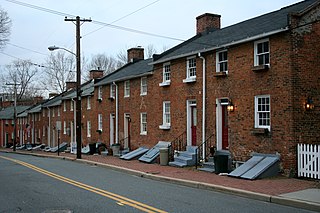
Oella is a mill town on the Patapsco River in western Baltimore County, Maryland, United States, located between Catonsville and Ellicott City. It is a 19th-century village of millworkers' homes.

Maryland Route 99 is a state highway in the U.S. state of Maryland. Known as Old Frederick Road, the state highway runs 7.57 miles (12.18 km) from MD 32 near West Friendship east to U.S. Route 29 in Ellicott City. MD 99 parallels the north side of Interstate 70 (I-70) through a rural and suburban area in northeastern Howard County. MD 99, which follows the original 18th-century road west from Baltimore, was constructed as part of three state highways: MD 99, the original MD 100, and MD 105. All three highways were constructed between the early 1920s and early 1930s. MD 99 originally turned south along St. Johns Lane to US 40 and MD 144; in 1956, the state highway was rerouted along part of MD 100 and all of MD 105 to downtown Ellicott City. MD 99's eastern terminus was rolled back to US 29 in two steps in the late 1970s and late 1980s.
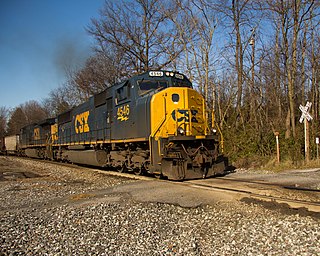
The Old Main Line Subdivision is a railroad line owned and operated by CSX Transportation in the U.S. state of Maryland. The line runs from Relay west to Point of Rocks, and was once the main line of the Baltimore and Ohio Railroad, one of the oldest rail lines in the United States. At its east end, it has junctions with the Capital Subdivision and the Baltimore Terminal Subdivision; its west end has a junction with the Metropolitan Subdivision.

Bloede's Dam was a hydroelectric dam on the Patapsco River in Maryland. Built in 1906, it was the first submerged hydroelectric plant—that is, the power plant was housed under the spillway. It was also one of the earliest dams constructed of reinforced concrete. The dam was demolished in 2018 and its site is now part of Patapsco Valley State Park Avalon Area.
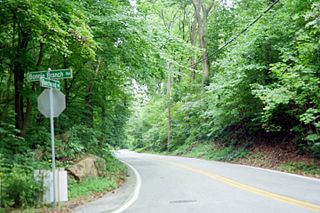
Ilchester is an unincorporated community and census-designated place in Howard County, Maryland, United States. The population was 23,476 at the 2010 census. It was named after the village of Ilchester in the English county of Somerset.

Patapsco Valley State Park is a Maryland state park extending along 32 miles (51 km) of the Patapsco River south and west of the city of Baltimore, Maryland. The park encompasses multiple developed areas on over 14,000 acres (5,700 ha) acres of land, making it Maryland's largest state park. In 2006, it was officially celebrated as Maryland's first state park, its first formation being in 1906. Patapsco Valley State Park is managed by the Maryland Department of Natural Resources.
The Historical Ellicott City/Baltimore Trolley Line #9 Trail is a 1.25-mile (2.0 km) trail in western Baltimore County, Maryland. It begins at the west end of Edmondson Avenue and extends from Catonsville through Oella to Main Street, Ellicott City. The trail follows what was originally part of the Catonsville and Ellicott City Electric Railway Company trolley line that shuttled passengers between Ellicott City and Baltimore from the late 1890s to the mid-1950s.

Henryton State Hospital is a now-demolished hospital complex in Marriottsville, in southern Carroll County, Maryland, just across the Howard County line. The complex was located within Patapsco Valley State Park and along its southern end runs CSX's Old Main Line Subdivision and is very close to the Henryton Tunnel. The Henryton State Hospital center, or the Henryton Tuberculosis Sanatorium as it was called, was erected in 1922 by the Maryland Board of Mental Hygiene. It was established as a facility to treat African Americans suffering from tuberculosis. This was one of the first such facilities in Maryland erected to provide African Americans with the same level of treatment as white people. Other accounts state that this was more of containment Hospital rather than a treatment facility. They contend that Henryton was used more for the exile and quarantine of tuberculosis patients.

The Elkridge Furnace Complex is a historic iron works located on approximately 16 acres (6.5 ha) at Elkridge, Howard County, Maryland.
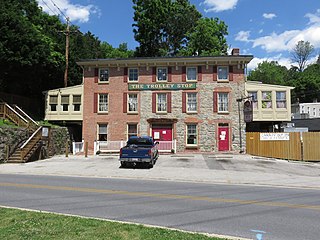
Ellicott's Mills Historic District is a national historic district at Oella, Baltimore County, Maryland, United States. It is on the east bank of the Patapsco River, opposite Ellicott City. This historic district designation relates to the industrial operations of the Ellicott family from the 1770s through the mid-19th century. It consists of the sites of historic buildings including: an 18th-century building, a section of an 18th-century mill incorporated in a 20th-century factory, a 19th-century tavern, 19th-century workers housing, and an 1859 Italianate villa built by John Ellicott. Historically, these industrious mills were served by the major east–west route in Maryland during the early 19th century, the old National Pike. Also in the district is the mammoth multi-story Wilkins-Rogers Company flour plant, which is located on the site of the 1792 Ellicott Flour Mill, the first merchant flour mill in the United States.
The Orange Grove Flour Mill was a flour mill established in 1856. It was one of the leading flour mills in the Mid-Atlantic states until it was destroyed in a fire in 1905.
St. Marys College was a Roman Catholic school in Ilchester, Maryland near modern Ellicott City, Maryland in Howard County. The ruins are near Ilchester and Bonnie Branch roads. The upper college building was built in 1868 consisting of a cupola-topped eighteen-bay-by-five-bay building with a five-bay-by-five-bay projection. A three-bay-by-three-bay, five-story L-shaped addition is included, with all of the structure on a stone foundation. A three-story chapel was attached to the building in 1882. In 1934 a fifth floor was added throughout. A statue of Madonna with Child was situated in a niche.
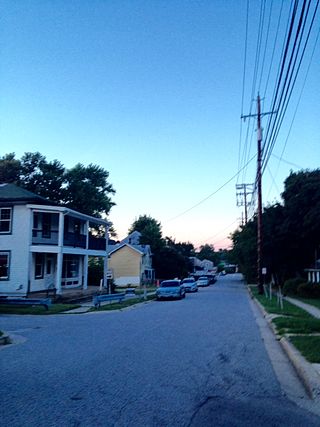
Elkridge Landing was a Patapsco River seaport in Maryland, and is now part of Elkridge, Maryland. The historic Elkridge Furnace Inn site resides within the Patapsco Valley State Park.
Woodlawn or Papillon was amanor home in Ellicott City, Howard County, Maryland in the United States.

The Patapsco Hotel is historic granite building located in Ellicott City, Maryland, on the western bank of the Patapsco River.

The Patapsco Valley is a small valley surrounding the Patapsco River in central Maryland. The region is known for its historical significance as a major economic and industrial center in the eighteenth and nineteenth centuries.

The Grist Mill Trail is a 5.0 mile long hiking and biking trail located in Patapsco Valley State Park in the Baltimore County side of the Patapsco Valley near Catonsville, Maryland. The paved pathway runs parallel to the Baltimore and Ohio Railroad to the north, and the Patapsco River to the south.
















